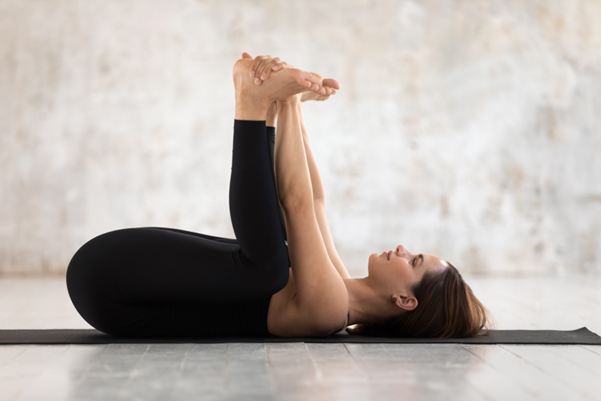
Unlocking Vitality: Yoga for Pelvic Floor Health with Uptown Yoga
January 26, 2024
Have you made New Year’s resolutions for 2024? Don’t worry – we’re not about to check whether you’ve stuck to them or have had a couple of lapses already. There’s also no judgment if you’re not into making resolutions. But whether you like that particular term or not, most of us start the year with plans or hopes for the months ahead. How about doing something to improve your overall health and vitality?

If that’s one of your goals for 2024, this is the blog post for you. We’re going to focus on an area of the body that is critical when it comes to feeling better every day. It’s also a little delicate – we’re talking about yoga for the pelvic floor. Read on to learn more.
Why Are Our Pelvic Floor Muscles So Important?
Our pelvic floor muscles are a classic example of a muscle group that is often overlooked – until problems arise. These muscles may be all but invisible, but they are true multitaskers when it comes to protecting other body parts.
When we talk about the pelvic floor, we’re not only referring to muscles. The pelvic floor also consists of connective tissues. Together, muscles and connective tissues support some of the most important organs in your pelvis. Your bladder, internal reproductive organs, and your large intestine all depend on the pelvic floor to stay in place while still being flexible enough to accommodate and regulate core bodily functions.
In all genders, going for a pee or a poop and having sex all depend on a strong yet flexible pelvic floor. Insufficient pelvic floor strength can lead to incontinence and make it harder for your body to absorb pressure from coughing or lifting, for example. If your pelvic floor suffers, other body parts including your spine, hips, and the pelvis itself lose a layer of protection from outside impact.
How Can Yoga Improve Pelvic Floor Function?
There are a number of reasons why your pelvic floor muscles may have suffered. However, for the purposes of this blog, we’ll be focusing on yoga-based solutions and improvements.
A healthy pelvic floor needs to be both strong and flexible. Practicing yoga is one of the best ways to straddle this combination because many poses allow you to improve both and therefore address pelvic floor tightness as well as weakness.
How Can I Benefit From Yoga Poses to Strengthen the Pelvic Floor?
Not to put it too delicately, but a strong and flexible pelvic floor greatly benefits your love life, no matter your gender.
If that’s not high on your agenda, then improving basic bodily functions might be. A strong pelvic floor improves bladder control and minimizes accidental peeing when coughing or lifting heavy objects. A flexible pelvic floor can help relieve constipation or pelvic pain.
What’s more, once you start incorporating yoga poses to support your pelvic floor into your routine, you will soon notice a difference. Even with a few extra minutes, many yoga practitioners find they feel better after just a few weeks.

What Are Five of the Best Yoga Exercises for Pelvic Floor Health?
Are you ready to strengthen and lengthen your pelvic floor muscles? Here are five asanas to get you started.
Happy Baby Pose
Happy Baby Pose is a great pose to help you relax and lengthen your pelvic floor muscles while also improving mobility of the surrounding tissues. Aside from your pelvic floor, this asana loosens tight thigh and hip muscles which can contribute to overall tension in this area of your body.
Start by lying on the floor on your back. Lift your legs in the air and bring your knees to your chest. Grab the outside of your feet with your hands and pull your knees toward the floor. Keep your head on the floor and hold the pose for as long as you feel comfortable.
If this is too hard initially, practice on one side and then switch to the other.
Chair Pose
This is a great asana to strengthen and condition your pelvic floor and the surrounding muscles.
Start by standing with your feet hip-distance apart. Keep your weight on your heels and lower your hips as if you’re trying to sit down in a chair. Ideally, you want your thighs to form a 45-degree angle with the floor, and your knees should remain behind or in line with your toes.
Raise your arms until your elbows are parallel with your ears and hold for a few breaths. You can also place yoga blocks between your feet and your thighs to engage the muscles around your pelvic floor.
Bridge Pose
Bridge pose is another pelvic floor-strengthening asana. At the same time, this pose can help you condition the muscles in your lower back, glutes, and core.
Begin by lying flat on the floor with your knees bent and your feet flat on the floor. Your fingertips should just about reach your heels. Place your arms by your sides or roll them under your shoulders, interlacing your hands under your back.
On your next exhale, engage your pelvic floor and your core, press into your arms, squeeze your glutes, and lift your hips until they are parallel with your knees. Hold for a few breaths. To make this pose more comfortable, you can place a block between your thighs.
Static Squat
Practicing this pose helps strengthen and lengthen your pelvic floor muscles and connecting tissues. It’s also a great hip opener.
With your feet a little more than hip-width apart and your toes turned slightly outward, lower your hips as far as you can without causing discomfort. Put your elbows inside your knees and press your palms together to allow your elbows to press your knees apart. Lengthen your spine and hold the pose for a few breaths.
If your hips or pelvic floor are very tight, you can sit on one or two yoga blocks to encourage relaxation.
Reclining Twist
This asana is not strictly speaking a pelvic floor exercise, but it is a great option for lengthening surrounding muscle groups to regain flexibility in your pelvic floor.
Start on your back and bring your knees toward your chest—roll to one side, stacking your legs on the floor. Place an arm on your knees to encourage relaxation and rest the other arm on the floor at shoulder height. Turn your head to look away from your knees. Hold for a few breaths, then repeat on the other side.
This twist stretches the connective tissues on your lumbar spine, abdominal wall, and sacrum. By allowing these tissues to relax, you’re making it easier for your pelvic floor to follow suit.
How Can I Incorporate Yoga for the Pelvic Floor into My Routine?
Incorporating these asanas into your yoga practice doesn’t need to be difficult, but if you’re unsure how to get started, join one of our Flow and Meditation classes today for more inspiration. Alternatively, talk to our knowledgeable instructors to find out more about supporting and optimizing pelvic floor function through your yoga practice. Incorporate these asanas into your yoga practice today and feel the difference faster than you think!




